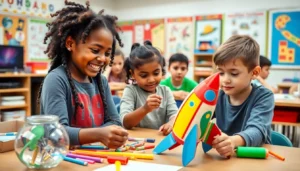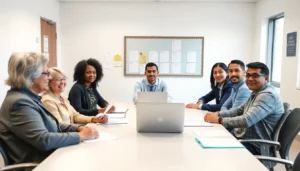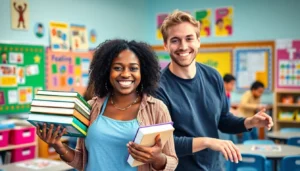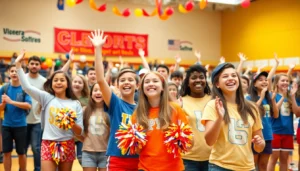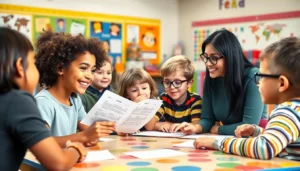Table of Contents
ToggleIn a world where traditional classrooms sometimes feel like a scene from a sitcom gone wrong, alternative education steps in like the quirky best friend ready to save the day. It’s not just about dodging the usual chalk dust and rigid schedules; it’s a refreshing approach that tailors learning to fit individual needs. Imagine a place where creativity thrives, curiosity reigns, and textbooks take a backseat to real-world experiences.
Alternative education offers a buffet of options, from Montessori to homeschooling, catering to diverse learning styles and interests. It’s like finding the secret menu at your favorite restaurant—exciting, unexpected, and oh-so-satisfying. With this approach, students aren’t just numbers; they’re unique individuals on a journey to discover their passions and strengths. So, why settle for cookie-cutter education when there’s a whole world of alternatives waiting to be explored?
What Is Alternative Education?
Alternative education encompasses various non-traditional learning methods. These approaches prioritize individual learning styles and needs, often diverging from conventional education systems. Many parents and educators turn to options like Montessori, Waldorf, and homeschooling to create tailored educational experiences. Each method emphasizes hands-on learning and creativity, engaging students in ways that resonate with them personally.
Homeschooling offers flexibility in curriculum choices. Families design educational pathways that align with children’s interests, fostering a love for learning. Montessori schools focus on child-led activities, allowing students to explore subjects at their own pace. Frequently, this approach nurtures autonomy and critical thinking skills.
Waldorf education integrates arts and culture into the curriculum. Lessons often include storytelling and creative expression, fostering holistic development. This method encourages emotional intelligence and social skills, preparing students for collaborative environments.
Project-based learning also stands out in alternative education. Students tackle real-world challenges through collaborative projects, enhancing problem-solving abilities. Curriculum choices in this model often reflect students’ passions and pursuits, leading to increased motivation.
Socialization opportunities in alternative education settings vary. Co-ops and learning pods provide environments where children connect and grow together. These settings often promote peer interaction and teamwork, essential components of a child’s educational journey.
Ultimately, alternative education seeks to cultivate a lifelong love for learning. By prioritizing the unique needs of each student, this approach forms tailored experiences conducive to growth. The emphasis on individuality facilitates a comprehensive understanding of education, pushing traditional boundaries.
Key Characteristics of Alternative Education
Alternative education features various characteristics that distinguish it from traditional methods. These traits offer unique advantages to students and parents seeking more personalized learning experiences.
Flexibility in Learning
Flexibility plays a crucial role in alternative education. Students experience tailored learning schedules that adapt to their rhythms and needs. Many programs allow families to choose curricula that align with their children’s interests. Experimentation with different subjects can take place at students’ own pace. This approach fosters a commitment to learning, as enthusiasm grows when students engage in topics they genuinely care about. Parents often report increased satisfaction with educational outcomes when flexibility is prioritized.
Focus on Individual Needs
Individual needs take center stage in alternative education. Each student’s learning style and interests significantly shape their educational journey. Educators often assess these unique needs, providing customized strategies to ensure optimal growth. Some settings employ small class sizes, which support personalized attention from teachers. Direct feedback helps identify strengths and areas for improvement. By recognizing and addressing each student’s capabilities, alternative education systems encourage confidence and achievement while promoting a genuine love for learning.
Types of Alternative Education
Alternative education encompasses several unique methods that cater to individual learning preferences. Each type highlights different philosophies and approaches to education, enriching the overall experience.
Montessori Education
Montessori education emphasizes child-led learning experiences. Students engage with hands-on materials that encourage exploration and independence. Educators act as guides rather than traditional instructors, fostering an environment where curiosity thrives. Classrooms often promote mixed-age groups, allowing younger students to learn from their older peers. This setup nurtures collaboration and social skills while reinforcing academic concepts through practical activities. The structure emphasizes critical thinking and problem-solving abilities, equipping children with essential life skills.
Waldorf Education
Waldorf education integrates arts, culture, and core subjects to foster holistic student development. This approach values creativity and imagination, ensuring that learning experiences resonate with students on multiple levels. Curriculum pacing often aligns with children’s developmental stages, addressing emotional, social, and academic needs. Teachers focus on storytelling, arts, and hands-on activities, creating a well-rounded educational experience. Additionally, outdoor play and nature activities support physical and emotional growth, emphasizing the importance of connection to the world around them.
Homeschooling
Homeschooling allows families to personalize their educational journeys significantly. Parents design curricula that align with their children’s interests and learning styles, fostering a deeper engagement with material. Flexibility in scheduling and learning methods offers opportunities for experiential learning beyond traditional settings. Family-led education often encourages stronger bonds and personalized attention, allowing for immediate feedback and support. Various resources and communities exist to assist homeschooling families, ensuring access to diverse learning materials and connecting them with others who share similar educational goals.
Benefits of Alternative Education
Alternative education offers unique advantages that enrich the learning experience. Students thrive in environments that promote individualized approaches, allowing for personal growth and development.
Enhanced Creativity
Creativity flourishes in alternative education settings. Montessori schools encourage hands-on learning, promoting imaginative exploration. Waldorf education integrates artistic activities, helping children express themselves in diverse ways. Students engage in project-based learning, which involves real-world challenges that spark innovation. Opportunities for collaboration with peers also inspire fresh ideas, fostering a culture of creativity. Programs focusing on personalized interests enable learners to pursue passions, allowing for deeper engagement with subjects.
Improved Critical Thinking Skills
Critical thinking skills develop significantly through alternative education methods. Students tackle complex problems within project-based frameworks, enhancing analytical abilities. Engaging in discussions with educators and peers encourages learners to evaluate different perspectives, cultivating open-mindedness. Customized learning plans focus on real-world applications, allowing students to connect knowledge with practice. Smaller class sizes facilitate meaningful interactions, where educators provide immediate feedback, leading to growth in reasoning skills. Overall, alternative education equips students with the tools to think critically and approach challenges effectively.
Challenges of Alternative Education
Alternative education faces several challenges, impacting its effectiveness and perception.
Misconceptions and Stereotypes
Common misconceptions surround alternative education. Many view these methods as less rigorous than traditional schooling. Stereotypes often depict alternative settings as unstructured or lacking discipline. These preconceived notions can lead to skepticism from parents, educators, and policymakers. Real concerns exist regarding accountability in alternative programs. Seeking clarification about specific educational outcomes can help counter these misunderstandings. Addressing these stereotypes fosters a broad acceptance of diverse learning approaches.
Resource Availability
Resources for alternative education can vary significantly. Families engaged in homeschooling often need access to instructional materials and support networks. Montessori and Waldorf schools require trained educators and appropriate environments for effective learning. Financial constraints may limit some families’ ability to choose or sustain alternative education options. Local and state regulations can also affect resource availability, putting additional pressure on educators and students. Ensuring equitable access to necessary resources remains crucial for the growth of alternative education systems.
Alternative education represents a transformative shift in how learning can be approached. By prioritizing individual needs and fostering creativity students are empowered to explore their interests and develop critical skills. This personalized approach not only nurtures a love for learning but also prepares students for real-world challenges.
Despite facing misconceptions and resource limitations alternative education continues to gain traction. As more families recognize its benefits the landscape of learning evolves. Embracing these diverse educational paths can lead to a more inclusive and effective system that values every student’s unique journey.

